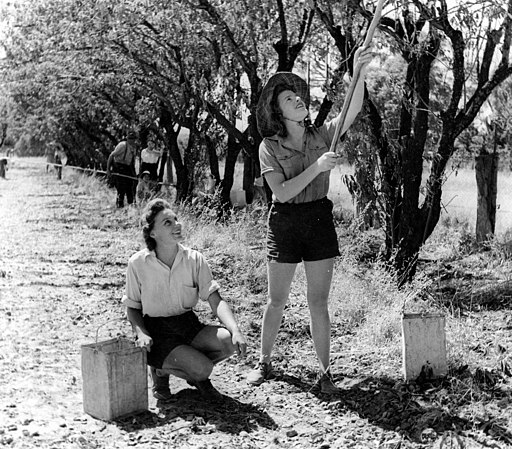They came from all over the country, anxious to do ‘their bit’. Many were very young, sometimes only sixteen, and some couldn’t stand the backbreaking work – picking crops, driving tractors, looking after the sheep and cattle and several other tasks, but they all tried. There is not enough information about these brave young women who served in Australia in World War Two, so I am making this website in tribute to them, and provide more information on their difficult work.

Concerns about a shortage of farm workers, workers in packing houses and canneries, disruption of supply chains and food production after World War Two began in 1939 led to the formation of State and private women’s land armies. Flax was also important because Britain couldn’t import it from Russia and Belgium any more after 1939, so it turned to Australia. Many Australian farms received government contracts to produce flax, and depots and mills were built in Victoria to handle the crops. There was also a Flax Productions Committee which had its headquarters in Melbourne.
One of these women’s organizations was the Women’s National Service, which held its first meeting at Sydney Town Hall on June 25, 1940. Over ten thousand showed up to this crowded meeting, such was the interest amongst women anxious to serve their country. This was an organisation which recruited and trained women in auxiliary occupations. It ran cookery, hygiene, and management courses for those in charge of the girls who worked on the farms, and groups of women were sent to the country to serve in the camps, which were usually extremely basic. The Country Women’s Association also established local groups to help with the shortage of labour in the country.
After the Japanese attack on Pearl Harbor in December 1941, the Federal government realised that a national land army was needed, based on the British land armies of the First World War and this war. This was organized by each State, but placed under the Department of Manpower. Each state appointed a Superintendent to supervise the members The Land Army was divided into two: full-time members who worked for at least a year in the service, and seasonal members. Full-time members received badges, a uniform, working clothes and equipment. The part-time members usually only worked for four weeks at a time, and received badges, working clothes and equipment on loan. Many came from the city, and were sometimes shocked by the harsh conditions of country life. Rural girls often joined the official services, because they didn’t want to work in the country.
The girls had to be between 18-50 who were British subjects, or immigrants from Allied countries. Many were under 18, however. Girls who were under 18 were required to have the consent of their parents or guardians. The army worked for 48 hours a week, but many, no doubt, worked longer hours for no pay, and their wages started at the minimum wage of 30 shillings a week. They were paid much less than men for the same week. There were over 3,000 members in the AWLA.
In 1942, the Minister for Labour and National Service recommended that the AWLA be registered as a fourth service, but this was not acted on before the end of the war. It was not until 1997 that many former members were recommended for the Civilian Service Medal.
Sources
Hardisty, Sue (ed) Thanks Girls & Goodbye: The Story of The Australian Women’s Land Army 1942-45, Viking O’Neil, Melbourne 1990 (1989).
Scott, Jean, Girls with Grit, Memories of The Australian Women’s Land Army, Allen & Unwin, 1995.
State Library of Queensland. 2022. The Australian Women’s Land Army Records 1942-1975. [online] Available at: <https://www.slq.qld.gov.au/blog/australian-womens-land-army-records-1942-1975> [Accessed 20 May 2022].